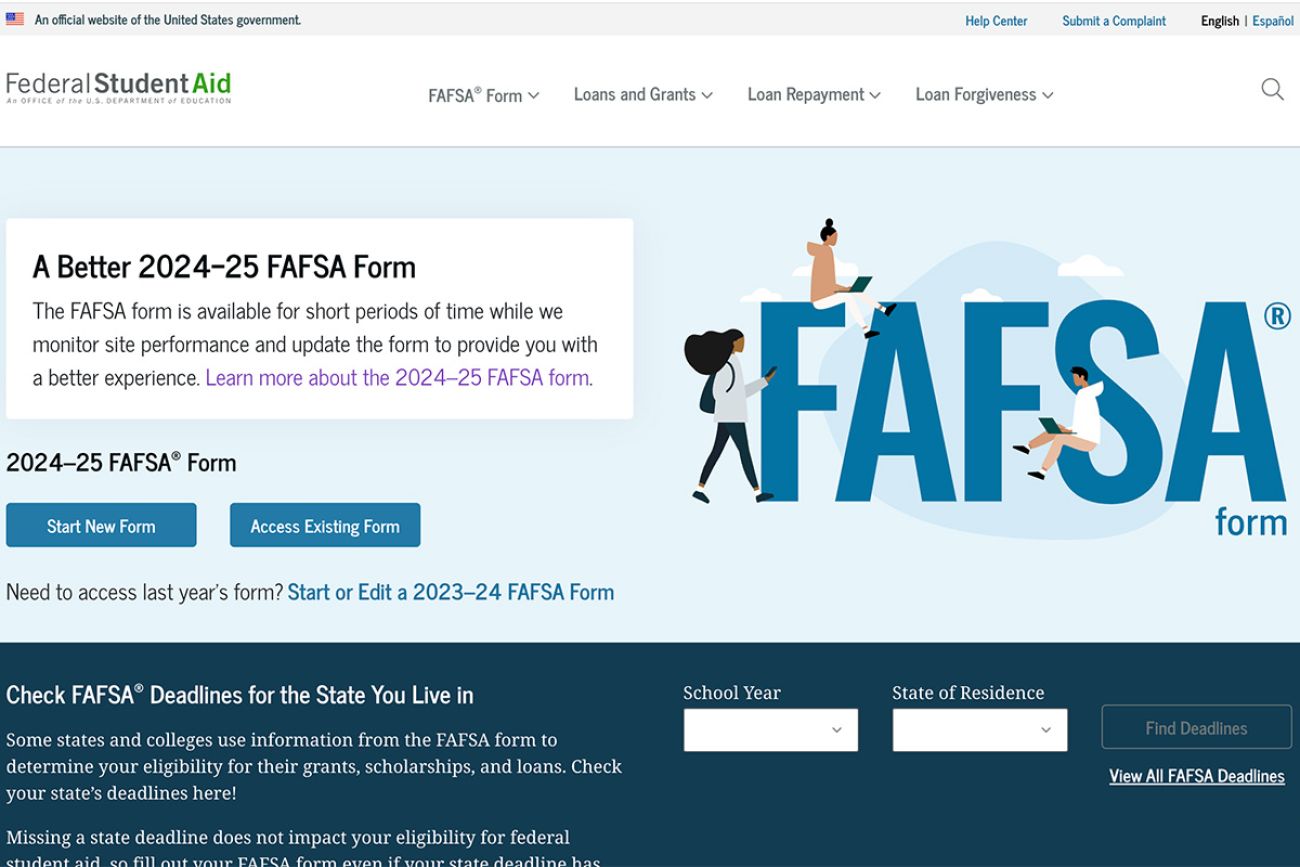New FAFSA form: What MI students need to know about 2024-2025 application

- Students and families can now access the new FAFSA form, though access has been spotty in the first few days
- Colleges and universities use FAFSA information to determine student eligibility for loans, scholarships and grants
- Completing the FAFSA is a requirement for recent Michigan high school graduates to qualify for a new state scholarship
The federal financial aid form college students submit to determine their eligibility for scholarships, grants and student loans is now intermittently available.
The “soft launch” of the new FAFSA form — touted as shorter and simpler than the previous version — has elicited plenty of grumbling from students due to maintenance pauses throughout its first few days of its availability.
Adding to the anxiety, students and families will have a narrower window this year to complete the form. In past years, the FAFSA (Free Application for Federal Student Aid) became available in early October. This year, the revised version was not released until Dec. 30.
Related:
- After pandemic dip, Michigan universities see bump in freshman enrollment
- Michigan may require high school seniors to file FAFSA financial aid form
The federal government won’t send the financial information to the schools until the end of January, which gives schools less time to put together financial aid offers. Also, students still face specific school and state deadlines.
Colleges, universities and trade schools and states use the information provided in the FAFSA to determine if students qualify for school, state and federal programs to help with education costs.
In Michigan, the form is also a requirement for two key programs that help students pay for college. The Michigan Achievement Scholarship pays up to $5,500 a year for qualified in-state students to attend a Michigan public university; up to $4,000 a year to attend an independent nonprofit college; $2,750 to attend a community college and $2,000 to attend a career training program for high school graduates.
The Michigan Reconnect program pays in-district tuition costs for adults 21 and older attending their local community college.
Due to changes mandated by Congress, the new FAFSA should be more streamlined, with fewer questions, but the rollout of the new form will likely require some patience from those using the form.
As of Wednesday, the Student Aid website said the 2024-2025 form remains “available periodically.”
“During the soft launch, the FAFSA form will be available for short periods of time while we monitor site performance and form functionality. We will initiate pauses for site maintenance and to make technical updates as needed to provide you with a better experience.”
If someone submits the form during the soft launch, their information will be saved and they won’t need to resubmit the information, according to the site. For those who can’t access the form during the soft launch, the site encourages people to try again later.
Ryan Fewins-Bliss, executive director of the Michigan College Access Network, a group that works to increase college access particularly for low-income students, students of color and first-generation students, said it’s important to not give up on completing the form.
“Often folks, they feel like they either don't make enough money or make too much money to fill it out,” he said. “They make a lot of assumptions about what comes out of that. And it's a good idea to have everyone just go through it and see what the options are.”
Here is what to know about filling out the FAFSA.
Who should fill out the form?
The Federal Student Aid site states that “any student, regardless of income, who wants to be considered for federal, state, and school financial aid programs” should fill out the FAFSA.
Grants, scholarships and work study are programs you do not have to pay back. Loans do have to be paid back.
The U.S. Department of Education said the new form, which takes into consideration new student aid calculations, will help nearly 20,000 more Michigan students be eligible for the federal Pell Grant, which is typically awarded to undergraduate students from low-income backgrounds.
How do I fill out the form?
You can fill out the form online at FAFSA.gov or you can submit the form by mail.
“If you get stuck, ask questions,” said Alisha Cederberg, a former community college financial aid administrator and the current program administrator in the state’s Office of Sixty by 30 office, which aims to get more Michigan students to pursue college or trade programs after high school. Cederberg trains people on how to fill out the FAFSA and said she recently filled out the 2024-2025 form in about 10 minutes for her doctoral program.
She recommends high school students sit down with their parents to fill the form out together.
A student and any contributors to the form will need to create a login on the Student Aid website. The login is sometimes referred to as an “FSA ID.”
You will need your social security number to create an account.
A contributor could include the student, student’s spouse, or a parent (biological, adoptive, or step parent).
“A contributor is anyone required to provide consent and approval to have their federal tax information transferred directly from the IRS into the FAFSA form, as well as a signature on the form,” according to a Federal Student Aid video. (The video is also offered when someone begins the online FAFSA process.)
A person identified as a contributor is not automatically on the hook to pay for the student’s education.
“Being identified as a contributor doesn’t mean they’ll be financially responsible,” the video says.
Each person who contributes to the FAFSA form has a separate login. A contributor can create an account without a social security number to fill out their portion of the 2024-2025 FAFSA online.
The Michigan College Access Network has published guides for determining who is considered a contributor. The guides are available in English, Spanish and Arabic.
The Student Aid site also has a page focused on who is considered to be a parent.
There is an updated system for retrieving tax information designed to make things easier as well.
The form is not available when I log on. What should I do?
Sarah Kasabian-Larson, director of scholarships and financial aid at Central Michigan University, said students should try throughout January to begin the process of completing the FAFSA. There is no need to panic this early in the cycle, she said. In fact, the FAFSA website says the government won’t even be turning over student information to colleges until later in January.
“Financial aid is definitely complicated and overwhelming,” Kasabian-Larson said. “And I have been watching (Federal Student Aid’s) social media and I see a lot of confusion right now going on, and I just hope that people have the right tools to reach out to colleges and universities to help clear some confusion so they're not stuck in this limbo right now.”
How does the information I provide get used?
Schools use the information to create their financial aid packages. The packages include information on what school, state and federal aid a student is eligible for.
Students using the online form can select up to 20 schools to send financial information to. They can select up to 10 schools if they use the paper form.
If you are curious about how much aid you may receive, you can use the Federal Student Aid Estimator tool which asks questions about your or your family’s income and assets. The tool is not a replacement for filling out the FAFSA.
What is a ‘Student Aid Index’?
The Student Aid Index (SAI) is a number that schools use to determine how much federal student aid a person qualifies for.
If you have filled out the FAFSA before, you may be familiar with the term “expected family contribution” or EFC. The student aid index replaces the expected family contribution.
The SAI is also a key number used to determine if a student qualifies for the Michigan Achievement Scholarship. Students qualify for the scholarship if they have an SAI of $30,000 or less and if they meet other requirements.
Once someone has completed the FAFSA, they will receive a confirmation page that includes information on the student’s estimated Student Aid Index and if they are likely to qualify for a federal Pell grant.
“The Student Aid Index on the confirmation page is only an estimate. The official Student Aid Index will appear on the FAFSA Submission Summary,” the Student Aid site says.
After you submit the form, the U.S. Department of Education processes your information and sends information to the schools you list on the form.
Where can I get help with my FAFSA?
The Student Aid website includes information on how to complete the form, a help page with answers to common questions and videos to help with the FAFSA process. You can also live chat, email or call the Federal Student Aid Information Center and talk to a virtual assistant named Aidan.
A high school counselor can help with the FAFSA and the Michigan College Access Network will soon publish a list of about 600 trained individuals across the state who can also help you with FAFSA questions. The list will be on micollegeaccess.org.
You can also ask questions to the financial aid office at the school you hope to attend or a local college nearby.
Michigan Education Watch
Michigan Education Watch is made possible by generous financial support from:
Subscribe to Michigan Education Watch
See what new members are saying about why they donated to Bridge Michigan:
- “In order for this information to be accurate and unbiased it must be underwritten by its readers, not by special interests.” - Larry S.
- “Not many other media sources report on the topics Bridge does.” - Susan B.
- “Your journalism is outstanding and rare these days.” - Mark S.
If you want to ensure the future of nonpartisan, nonprofit Michigan journalism, please become a member today. You, too, will be asked why you donated and maybe we'll feature your quote next time!






